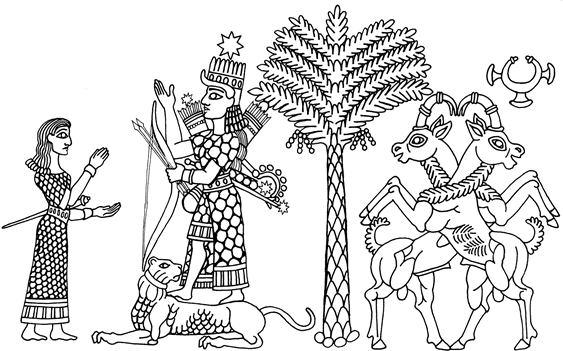In Ancient Greece, Hades was known as the king of the underworld, lower world or Tartarus, and lord of the dead men. Hades is called the infernal Zeus (Zeus katachthonios), the unseen king who can make himself and others invisible and the king of the shades (anae enerôn, Hom. Il. ix. 457, xx. 61. xv. 187, &c.). He is often depicted as “black” in old paintings and depictions.
The word infernal is derived from the Latin infernalis, inferna, and infernus, which means “below, underground, and the lower regions.”

The moon was considered the “Upper Hades,” paradise or heaven, which was the abode of men’s departed spirits. Plutarch had written, “of these, as has been said, the moon is the element, for they are resolved into it as the bodies of the dead are resolved into the earth.”
He further writes, “This happens quickly to the temperate souls who had been fond of a leisurely, unmeddlesome, and philosophical life, for abandoned by the mind and no longer exercising the passions for anything they quickly wither away.
Of the ambitious and the active, the irascible and those who are enamored of the body, however, some pass their time as it were in sleep with the memories of their lives for dreams as did the soul of Endymion; but, when they are excited by restlessness and emotion and drawn away from the moon to another birth, she forbids them to sink towards the earth;.and keeps conjuring them back and binding them with charms, for it is no slight, quiet, or harmonious business when with the affective faculty apart from reason they seize upon a body.
In the Biblical sense, Church Apostles taught that Christ went to the upper Hades or paradise where all righteous souls that were in covenant with God went to Abraham’s bosom where they await Judgment Day.
The Roman poet, Publius Papinius Statius, writing in the 1st century AD, referred to the lower regions of Hades in his Thebaid as the warden of the Larvae (Shades).
“The Warden of the Larvae and the third heir of the world, after the lot’s unkind apportioning, leapt down from his chariot and grew pale, for he has come to Tartarus and heaven was lost forever.” (Statius, Thebaid)
I have written about these larvae in my article, “Lemures: The Roman Parasitic Larvae Spirits,” where I explain that in ancient Roman mythology, the Lemures (lem’u-rez) were greatly feared evil spirits who caused disease and infection. They were thought to be malignant spirits, specters or ghosts who haunt the earth by night and to possess great power for evil over the living.
In the Apocolocyntosis 9.3 (about the deification of Emperor Claudius, attributed to Seneca) and Pliny’s Natural History, these Lemures/Larvae are tormentors of the dead.
Church Father and Doctor, Saint Augustine had written about the Lemures and Lares. Augustine writes in chapter 11 of the City of God;
“Lares if good,
Lemures (larvae) if evil, and
Manes if indeterminate.”
Augustine further writes; “[Plotinus (3rd century A.D.)] says, indeed, that the souls of men are demons, and that men become Lares if they are good, Lemures or Larvae if they are bad, and Manes if it is uncertain whether they deserve well or ill. Who does not see at a glance that this is a mere whirlpool sucking men to moral destruction?
For, however wicked men have been, if they suppose they shall become Larvae or divine Manes, they will become the worse the more love they have for inflicting injury; for, as the Larvae are hurtful demons made out of wicked men, these men must suppose that after death they will be invoked with sacrifices and divine honors that they may inflict injuries. But this question we must not pursue. He also states that the blessed are called in Greek eudaimones, because they are good souls, that is to say, good demons, confirming his opinion that the souls of men are demons.”
The 18th century French Catholic Gnostic, Eliphas Levi writes of “Larvae and lemures, shadowy images of bodies which have lived and of those which have yet to come, issued from these vapors by myriads…”
33rd Degree Freemason, Robert McCory writes about the Lares, Lemures, and Manes in the “Illustrated History and Cyclopedia of Freemasonry.” Macoy had said;
“In Roman antiquity, the gods of the lower world; the benevolent deities; generally applied to the souls of the departed. According to Apuleius, the Manes were originally called Lemures, and consisted of two classes—the Lares and the Larvae; the former of whom were the souls of those who had led virtuous lives, and the latter of those who had lived improperly. At a later period the term Manet came to be a general designation for both.”
All these myths if Hades with the various statements and claims written by some of the most esteemed philosophers for the last 2,500 or so years we can now verify as fact as I have documented thoroughly here on my blog, which I contend are fungal infections causing people’s mind and bodies to be taken over by who our ancestors called Larvae sprits and their Lord and King is Hades.
A type of pathogenic fungal hive mind that acts as earth’s king of scavenging its filaments to punish the very ignorant people of our modern-day who do not use their human minds and live improperly or as Christian would say, they are sinful and have let the Devil and his Demons into their lives.
These are the people I write and talk about in my Cult of Demons and METH Demons media series where normal people go crazy and murder people while making claims of seeing demons and the Devil.
I contend that our ancestors would say they are all controlled by the Noos of Hades and his legions of evil demons. A hive mind hell-bent on death and destruction in which drugs like METH, heroin, fentanyl, bath salts, and even prescription drugs can act like a bullet train to hell where people lose their minds quickly to become real life Demons who cause mayhem in whatever house and town they dwell.

Homer, writing in the Iliad, calls him Aides as lord of the dead men who drew the lot of the mists and the darkness.
Plato observes that people preferred calling him Pluton (the giver of wealth) to pronouncing the dreaded name of Hades or Aides. (Crazy. p. 403) Plutarch, in his book on Theseus, portrays him as “Aidoneus or Ancient Greek: Ἀїδωνεύς,” a mythical Molossian King who ruled over Epirus. In this myth, Aidoneus had promised his daughter’s hand in marriage to whoever could subdue his dog Cerberus without harming him.
In the Orphic Hymn 70, the Erinyes are mentioned to be the children of Zeus Khthonios (Hades) and Persephone (Persephone). This is later supported by Statius (Roman epic C1st A.D.), mentioning: “[Hades] the father of the Eumenides (Erinyes).”
In Homer’s Illiad, the infernal Goddesses called Erinyes represent a powerful force in nature who are “those who beneath the earth punish whosoever has sworn a false oath.”
When swearing an oath to Achilles, he calls on Zeus, Earth, Sun, and “the Erinyes, who “under earth take vengeance on men,” or if this punishment is inflicted on those under the earth, that is, the dead. … earth, and “you who in the world below take vengeance on men who are done with life, whoever has sworn a false oath” (3.276–9).
Homer had described lord of the dead men who drew the lot of the mists and the darkness. He writes;
“We are three brothers born by Rheia to Kronos (Cronus), Zeus, and I [Poseidon], and the third is Aides [Haides] lord of the dead men. All was divided among us three ways, each given his domain. I [Poseidon] when the lots were shaken drew the grey sea to live in forever; Aides drew the lot of the mists and the darkness, and Zeus was allotted the wide sky, in the cloud and the bright air. But earth and high Olympos are common to all three.”
In the Homeric Hymn to Demeter, Hades is “appointed lord of those among whom he dwells;”
“Aidoneus Polysemantor (Ruler of Many), is . . . your [Demeter’s] own brother and born of the same stock: also, for honor, he has that third share which he received when the division was made at the first and is appointed lord of those among whom he dwells.”
The various names associated with Hades such as Aidoneus and his epitaphs, attach him to the king of the underworld and of shades who is the warden of larva or as we would call it in the Christian tradition, the Lord of Flies and the Prince of the Earth – AKA Hell.
To us modern English speaking people in the West, these ancient myths may seem fantastical and entirely fictitious in their origins. Still, the facts are that these ancient philosophers, historians, and poets had encoded ancient science as they understood it behind these stories. The names of these Gods and Goddesses as well as their traits, associations, and stories like that of Hades (Haidês) and, more appropriately, Aïdês or Aidôneus detail these facts.
For example, when we study Hades’ story, myths, and etymology, we can get a clear picture of the cosmological science that the Ancient Greeks had worked in earnest to develop and understand. The science of being human and the age-old drama that each soul partakes upon when born into this world and the journey we all take on our paths.
As Plutarch hath Said;
“Yet not forever do the Spirits tarry upon the moon; they descend hitherto take charge of oracles, they attend and participate in the highest of the mystic rituals, they act as warders against misdeeds and chastisers of them, and they flash forth as savior a manifest in war and on the sea.
For any act that they perform in these matters not fairly but inspired by wrath or for an unjust end or out of envy, they are penalized, for they are cast out upon earth again confined in human bodies.
To the former class of better Spirits, the attendants of Cronos said that they belong themselves as did aforetime the Idaean Dactyls in Crete and the Corybants in Phrygia as well as the Boeotian Trophoniads in Udora and thousands of others in many parts of the world whose rites, honors, and titles persist but whose powers tended to another place as they achieved the ultimate alteration.
They achieve it, some sooner and some later, once the mind has been separated from the soul.”
Hades possessed a helmet that rendered the wearer invisible (Il. v. 845), and later traditions stated that this helmet was given him as a present by the Cyclopes after their delivery from Tartarus. (Apollod. i. 2. § 1.)
Ovid lists his rank as the ‘void’;” [Zeus speaks :] ‘My rank is no greater [than Haides]. I hold court in the sky; another rules the sea [Poseidon], and one the void [Haides].'”
Seneca tells us he is king of the 3rd estate; “Dis [Haides] himself, who drew a lot equal to Jove’s [Zeus’s]. The king [Haides] of the third estate.
Thebaid says he is the warden of Lavae; “The Warden of the Larvae (Shades) [Haides] and the third heir of the world, after the lot’s unkind apportioning, leapt down from his chariot and grew pale, for he was come to Tartarus and heaven was lost forever.”

Moe is the founder of GnosticWarrior.com. He is a father, husband, author, martial arts black belt, and an expert in Gnosticism, the occult, and esotericism.




![How one in the province of the Northumbrians, rose from the dead, and related many things which he had seen, some to be greatly dreaded and some to be desired [Circ. 696 A.D.] | Book 5 | Chapter 11 How one in the province of the Northumbrians, rose from the dead, and related many things which he had seen, some to be greatly dreaded and some to be desired [Circ. 696 A.D.] | Book 5 | Chapter 11](https://www.gnosticwarrior.com/wp-content/plugins/contextual-related-posts/default.png)


